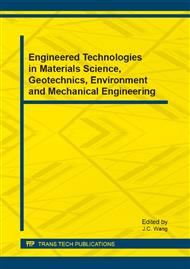p.80
p.85
p.90
p.95
p.101
p.107
p.112
p.117
p.124
Corrosion Inhibition Mechanism of the Inhibitor in Sedimentary Water of Storage Tank by AC Impedance Method
Abstract:
In order to study the corrosion mechanism of corrosion inhibitor on Q235 steel in tank sedimentary water, we prepared the simulation solution of sedimentary water which cintained : C1-10.0 g/L, SO42-1.0 g/L, HCO3- 0.75 g/L, Ca2+ 0.35 g/L, Mg2+ 0.2 g/L, according to the ion concentration under the condition of severe local corrosion. then the corrosion inhibitor was added into the solution, and the ac impedance was studied for different corrosion inhibitor by using the CHI660C electrochemical workstation. The results showed that when the zinc chloride compounds with ATMP (15:10), the high frequency area of ac impedance spectrum diagram is single capacitive reactance arc, and the radius of capacitive reactance arc existed concentration-dependent extreme behavior, which indicated that the adsorption film covering the metallic surface reduces the corrosion rate of metal; the radius was pretty small when only the zinc chloride or ATMP was added into the solution. When the compound ratio was 15:15, the radius reached the maximum, the adsorption resistance became bigger, and the adsorption film had good compactness thus the metal was not easy to be corroded. When Zinc chloride, ATMP and HEDP were compounded with 70 mg/L in total, a capacitive reactance arc appears in the high frequency area and a diffusion tail in the low frequency area, when the ratio was 15:7:3, the radius was the largest, and the performance was best.
Info:
Periodical:
Pages:
101-106
Citation:
Online since:
February 2013
Authors:
Price:
Сopyright:
© 2013 Trans Tech Publications Ltd. All Rights Reserved
Share:
Citation:


